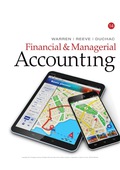
Domino's Pizza: Franchise segment
Domino's Pizza, Inc. is the second-largest pizza chain in the world. In the United States, Domino’s has 377 company-owned restaurants and 4,690 franchised restaurants. In addition, Domino's lias a supply chain that manufactures and delivers dough and other food products to all the domestic restaurants. Franchisees are required to purchase food products from the Domino's supply chain as part of their franchise agreement. Thus, in the United States, Domino's has three segments: Company-Owned Restaurants, Franchised Restaurants, and Supply Chain. Operating data for these three segments in the United States are as follows (in millions):
| Company-Owned Restaurants | Franchised Restaurants | Supply Chain | |
| Sales | $348 | $230 | $1,262 |
| Cost of sales | 267 | 1,132 | |
| General and administrative expenses* | 25 | 125 | 100 |
| Invested assets** | 32 | 30 | 146 |
*Allocation to segments assumed
**Allocation between Company-Owned and Franchised assumed
- A. Determine the income from operations for each segment.
- B. Determine the profit margin for each segment. (Round percentages to one decimal place.)
- C. Determine the investment turnover for each segment. (Round to one decimal place.)
- D. Use the DuPont formula to determine the return on investment for each segment. (Round to nearest whole percent.)
- E. Explain Domino’s business model and how it is related to ROI in each segment.
Trending nowThis is a popular solution!

Chapter 23 Solutions
Financial & Managerial Accounting
- The welding department had beginning work in process of 20,000 units, ending work in process of 26,000 units, and units transferred out of 60,000 units. What was the number of units started or transferred in?arrow_forwardVariable costs 24000 and fc 16500arrow_forwardFinancial Accounting Question can you please solve this problem?arrow_forward
 Financial And Managerial AccountingAccountingISBN:9781337902663Author:WARREN, Carl S.Publisher:Cengage Learning,
Financial And Managerial AccountingAccountingISBN:9781337902663Author:WARREN, Carl S.Publisher:Cengage Learning, Managerial AccountingAccountingISBN:9781337912020Author:Carl Warren, Ph.d. Cma William B. TaylerPublisher:South-Western College Pub
Managerial AccountingAccountingISBN:9781337912020Author:Carl Warren, Ph.d. Cma William B. TaylerPublisher:South-Western College Pub Financial Reporting, Financial Statement Analysis...FinanceISBN:9781285190907Author:James M. Wahlen, Stephen P. Baginski, Mark BradshawPublisher:Cengage Learning
Financial Reporting, Financial Statement Analysis...FinanceISBN:9781285190907Author:James M. Wahlen, Stephen P. Baginski, Mark BradshawPublisher:Cengage Learning Cornerstones of Cost Management (Cornerstones Ser...AccountingISBN:9781305970663Author:Don R. Hansen, Maryanne M. MowenPublisher:Cengage Learning
Cornerstones of Cost Management (Cornerstones Ser...AccountingISBN:9781305970663Author:Don R. Hansen, Maryanne M. MowenPublisher:Cengage Learning Managerial Accounting: The Cornerstone of Busines...AccountingISBN:9781337115773Author:Maryanne M. Mowen, Don R. Hansen, Dan L. HeitgerPublisher:Cengage Learning
Managerial Accounting: The Cornerstone of Busines...AccountingISBN:9781337115773Author:Maryanne M. Mowen, Don R. Hansen, Dan L. HeitgerPublisher:Cengage Learning Essentials of Business Analytics (MindTap Course ...StatisticsISBN:9781305627734Author:Jeffrey D. Camm, James J. Cochran, Michael J. Fry, Jeffrey W. Ohlmann, David R. AndersonPublisher:Cengage Learning
Essentials of Business Analytics (MindTap Course ...StatisticsISBN:9781305627734Author:Jeffrey D. Camm, James J. Cochran, Michael J. Fry, Jeffrey W. Ohlmann, David R. AndersonPublisher:Cengage Learning





